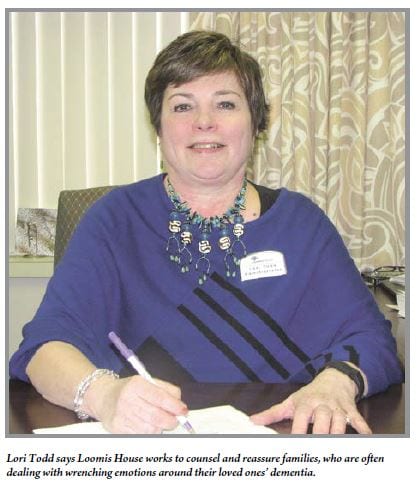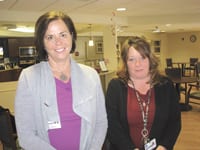Peace of Mind – As Dementia Population Rises, Memory-care Facilities Hone Their Mission
It’s not always easy to walk in someone else’s shoes, especially when that person suffers from dementia. But at Loomis House in Holyoke, they’re trying.
The training program for Loomis employees who work in the memory-care unit includes a mandatory activity called a ‘virtual dementia tour.’ They’re put through a sensory simulation including shoe inserts to make their feet uncomfortable, hazy goggles that mimic macular degeneration, headphones pumping in white noise like a ringing phone and an ambulance siren, and gloves to impair sense of touch.
“Then we ask them to do tasks. They quickly understand the frustration,” said Lori Todd, Loomis House administrator. “What we try to teach them is, you’re experiencing this for 10 minutes; imagine this all day long. Some people call it sundowning, but after eight hours, I’d be frustrated.”
A perceived need for better training led to the adoption two years ago of new regulations for Massachusetts nursing homes. Specifically, workers in specialized Alzheimer’s and dementia-care units are now required to undergo at least eight hours of initial training to care for such residents, and four additional hours annually. Proponents noted at the time that increased training is critical because roughly 60{06cf2b9696b159f874511d23dbc893eb1ac83014175ed30550cfff22781411e5} of nursing-home residents have some form of dementia.
At Loomis House, which maintains two separate memory-care units totaling 41 residents — there’s always a waiting list — administrators have taken staff training seriously for much longer than that, Todd said. In fact, the way staff assesses and engages its Alzheimer’s and dementia population is indicative of a wider trend in senior care, one that acknowledges that dementia is not going away as the Baby Boom generation continues to stream into its retirement years.
For example, while many facilities place residents with dementia into one of three categories of memory function, Loomis uses seven, in order to develop as individualized and specialized a care plan as possible. “If you’re stage three, you may be able to do a 100-piece puzzle for an activity,” Todd said. “In further stages, you may still be able to do a puzzle, but it may be a four-piece puzzle so you’re not frustrated.”
That said, the goal is to maintain as much independence as possible for residents through an individualized plan that determines what activities will keep them active and engaged. “We have to get an understanding of who they were and what made them tick — basically utilize that information to develop a plan that will be of interest to them.”
Similar strategies are put into play at Ruth’s House in Longmeadow, an assisted-living residence operated by JGS Lifecare. It features the Garden, a 30-bed memory-impaired unit with a central kitchen and living area and an enclosed, secured outdoor courtyard.
“It’s very home-like, which is really important,” said Anne Thomas, vice president of residential health. “But the one thing that distinguishes us from others is our exceptional programming structure, which is really important to people with dementia. If they’re not given some structure, they don’t do well. They need that schedule, that routine.”
Joelle Tedeschi, executive director of Ruth’s House, explained that every new resident is evaluated by the resident care director to determine how they fit into the site’s programming, which includes sensory activities, art and cooking groups, cultural-enrichment programs, and much more.
“We try to find out as much as we can about each person and craft programs based on that,” Thomas added. “It’s about engagement, but also creating an environment as much like their real home as possible. All the things a person enjoyed before should continue here — it shouldn’t change.”
Like Todd, Thomas noted that the population is aging, and the number of Americans living with some form of dementia — currently 5.3 million — is only expected to rise, meaning more nursing homes and assisted-living facilities are making a commitment to taking care of this population.
“With dementia, unfortunately, there’s no cure in sight; we don’t see the disease going away,” Thomas said. “Our responsibility is to create a wonderful program. Boomers are very discerning; they have disposable income, and they expect a lot, and they should. We’re designing things that we as Boomers would want for ourselves and our parents.”
Individual Focus
That begins with meeting each resident where they are, Todd said.
“There’s a lot of emphasis on understanding that we are guests in the home of the people who move in here. When people come to the dementia unit, they stay here; this is their home,” she said, explaining Loomis’ long-time philosophy of person-centered care. “So, if they want to get up at a certain hour, they can have their medicine when they wake up, rather than right at 8 in the morning. The satellite kitchen is open 24 hours a day, and they can eat when they want.”
Tedeschi said the Garden provides a similar sense of autonomy, including no set times for going to bed or waking up, and a kitchen where eggs can be cooked to order at any time. “Some folks don’t want to be up early for breakfast, so we’ll make them breakfast right before lunch if that’s their preferred time.”
The touches of home — and even pampering — continue with amenities like a full-service salon, live entertainers who get residents singing and dancing, and rules that allow residents to bring their pets with them. In addition, family members often volunteer to lead enrichment programs.
“Just today, one of the resident’s families brought in some old tools, and the residents sat around and reminisced about their lives. There were tools there I couldn’t identify, but some of our residents worked on farms as children and worked all day with these tools, and they talked about it. It was one of the most beautiful things I’ve ever seen.”
The Garden also recently introduced holistic-wellness activities including Reiki, aromatherapy, and reflexology, all conducted by student volunteers, said Mary-Anne DiBlasio, sales manager at JGS Lifecare, who has a background in alternative health. Meanwhile, a small activity room is being converted to a sensory meditation room.
In addition, JGS Lifecare takes part in the Music and Memory program, which works with residents’ families to develop a personalized playlist of meaningful songs, which they can play on donated iPods.
“We’ve seen some remarkable success stories with it,” said Alta Stark, director of marketing and public relations. “One woman’s daughter said she could tell immediately if her mother had her music therapy that day because she could have regular conversations with her. She said that had not happened for such a long time — it was like getting her mother back.”

Thomas is equally effusive. “I witnessed something walking through one day on the weekend — a resident in memory care was weepy, crying, and she wanted to go home. A life-enrichment person came over and consoled her, reassured her, got her iPod and earphones … and it calmed her down immediately.”
Tedeschi said it’s always a challenge to customize individualized programs when dementia has such a wide range of stages. Some residents can live relatively independently but need to be in a secure environment, she noted, while others wouldn’t even know how to press an alert pendant if they need help. “We need to anticipate what their needs would be. We have to customize a program for everyone and continue to add services according to their care needs.”
The complexity of caring for this population is why the Department of Public Health pushed for the new mandatory-training rules two years ago. In order to comply, staff members must be trained in the foundations of Alzheimer’s and other dementias, communication and connecting with these residents, techniques and approaches to care for this population, the components of person-centered care, working with families, the dietary needs of residents with Alzheimer’s and other dementias, social needs and appropriate activities in the care of such residents, recognizing and responding to caregiver stress, and preventing, recognizing, and responding to abuse and neglect of residents.
“Everyone who works here — even maintenance and housekeeping — has to have 12 hours of training,” Todd said. “And I’ve seen the benefits in training, retraining, and sensitizing. The regulations are strict, but it benefits the residents; it really does.”
Family Burdens
No one wants to admit their parent has dementia, Todd said, but the services provided in a specialized memory-care unit are critical when that decision looms.
“Most people who live here are a little more advanced than you see at home, and they’re at risk being in the community. Really, it’s a safety issue, and the caregiver can’t do it anymore,” she explained, noting that Loomis House provides a continuum of care that includes hospice services near the end of life.
It’s emotionally wrenching, she added, when someone understands that their loved one doesn’t recognize them in the same way anymore, but noted that Loomis provides a social worker to help families process that experience, and family support groups that help each other through the transition.
“At first, there’s a lot of fear, guilt, and anxiety,” she went on. “Then they begin to trust us. They see they can go home at night and their parents will be cared for. They have to trust that our people are caring for their parents because their parents can’t always tell them.”
Thomas agreed. “Sometimes it’s harder on the family than on the person who has this illness, to see that person changing before their eyes. That’s why we offer support groups for families.”
In addition, as part of the admissions process, Tedeschi said, families help residents assemble a shadowbox of photos and memories, to hang outside their room. Not only do the boxes help residents identify where their rooms are, they give the staff a better idea of what that person is all about. Families also fill out a profile about their loved one’s likes and dislikes, interests and hobbies, to help the staff build a satisfying daily routine.
Once they’re comfortable in their new home, DiBlasio said, “family members don’t have to be full-time caregivers anymore. We let sons be sons, daughters be daughters, and we become the caregivers. If we know the idiosyncrasies of the person, we can become part of the family, and they look at us as part of the team.”
The worst feeling a loved one can have, Thomas said, is the idea that “‘this is my mother; there’s nothing left to her.’ We want to demonstrate that this person has a lot left, and we want to bring that out in them. That’s our job, to bring out the best in the person so the family can experience that as well. The employees that work here find it gratifying that they can make a difference in many small ways, just by getting to know the person.”


Comments are closed.